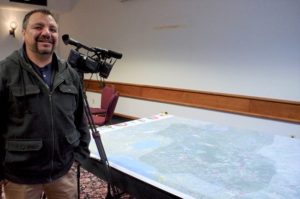Anishinaabe videographer brings to life the stories of Matawa First Nation citizens

By Rick Garrick
THUNDER BAY — Long Lake #58’s Sterling Finlayson recently captured stories from Matawa First Nation citizens about their lives on the land in Northern Ontario during the Matawa Environment Gathering 2019.
“We heard different stories on how they used to hunt when they were young and the traditional areas they would be able to go and frequent,” says Finlayson, a videographer and Confederation College business marketing student. “Now they can’t do it because of flooding in some areas and because of the climate — it doesn’t get as cold so the water doesn’t stay frozen so they are not able to go in that area.”
Finlayson captured the stories along with fellow videographer Andy Beaver, from Nibinamik, during the Story Room sessions, which were held on the first two days of the Dec. 10-12 gathering at the Valhalla Inn in Thunder Bay.
“The common thread throughout was water,” Finlayson says. “People said when they were young they were able to drink water from lakes and rivers without the threat of being ill or getting a rash on their bodies. But now you can’t even drink from the cleanest river or lake.”
In addition to sharing their stories during the Story Room sessions, the participants also posted information about how they lived on the land on a huge map of the Matawa region.
“We would ask them, ‘Where was this lake?’ or ‘Where was this hunting ground that you went on?’” Finlayson says. “Up north there are no roads, so we asked them, ‘How did you get around?’ and they would tell us of a little trail, how a river goes down one way and comes up the other way. It was pretty interesting actually.”
Finlayson says he enjoys interviewing people and making films.
“I think it is important for me to know my history,” Finlayson says. “Attending these conferences with Matawa, there’s people who are very knowledgeable about the past history of harvesting and about how climate change is actually affecting [Indigenous] people around northwestern Ontario.”
Kimberly Jorgenson, environmental services coordinator with Four Rivers Environment Services Group at Matawa First Nations Management, says the Story Room was held due to concerns expressed by Matawa citizens that the stories they shared at previous gatherings were not kept for future reference.
“So we set up that room in particular with a video camera to capture those stories firsthand,” Jorgenson says. “There’s lots of important reasons for that, one is that we can ensure their story lives beyond the life of this particular gathering.”
Jorgenson says it is also important to capture stories from the Elders when they are able to participate at gatherings.
“We’ve found it’s kind of an amazing tool when you can actually go to a community a few years later and play a video of an Elder,” Jorgenson says. “It can bring their story back to life and ensure it is passed on to future generations. We can all benefit from their knowledge and their wisdom and ensure that we put their words to action and that we show it proper respect and have it live on.”
Sarah Cockerton, manager of Four Rivers Environment Services Group, says one of the goals is to produce a story map from the input from the Story Room participants.
“One of the products we are hoping to see come out of that is kind of a story map overall where the comments, the stories are actually attached to a map and people can see and hear kind of what is going on out on the land,” Cockerton says.

